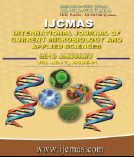


 National Academy of Agricultural Sciences (NAAS)
National Academy of Agricultural Sciences (NAAS)

|
PRINT ISSN : 2319-7692
Online ISSN : 2319-7706 Issues : 12 per year Publisher : Excellent Publishers Email : editorijcmas@gmail.com / submit@ijcmas.com Editor-in-chief: Dr.M.Prakash Index Copernicus ICV 2018: 95.39 NAAS RATING 2020: 5.38 |
A field experiment was conducted on a clay loam soil at Indian Institute of Rice Research (IIRR) formerly Directorate of Rice Research (DRR), Rajendranagar, Hyderabad, Telangana during the kharif seasons of 2015 and 2016 to study the “Assessment of production potential of rice with irrigation regimes and nitrogen management practices under different establishment methods”. The treatments consisted of three establishment methods Normal transplanting (NTP), Mechanized System of Rice Intensification (MSRI) and Drum seeding (DS) as main plot treatments, two irrigation regimes continuous flooding, Alternate wetting and drying at 5cm depletion as sub plot treatments and two nitrogen management practices (RDN - 100 % through inorganic and RDN - 75 % inorganic and 25 % organic) as sub-sub plot treatments summing upto 12 treatment combinations laid out in split-split plot design with three replications. Normal transplanting method required higher input energy. The gross energy output, net energy, energy use efficiency, energy productivity and energy intensity in economic terms recorded were significantly higher in MSRI than other establishment methods. Continuous flooding treatment recorded higher input energy, gross output energy and net energy. Energy use efficiency, energy productivity and energy intensity in economic terms recorded were higher with irrigation at 5cm depletion and these were at par with flooding method. The highest input energy consumed was with RDN (75 % inorganic and 25 % organic) management practice. The gross energy output, net energy, energy use efficiency, energy productivity and energy intensity in economic terms recorded were significantly higher with nitrogen application through RDN (75 % inorganic and 25 % organic) than inorganic N source.
 |
 |
 |
 |
 |